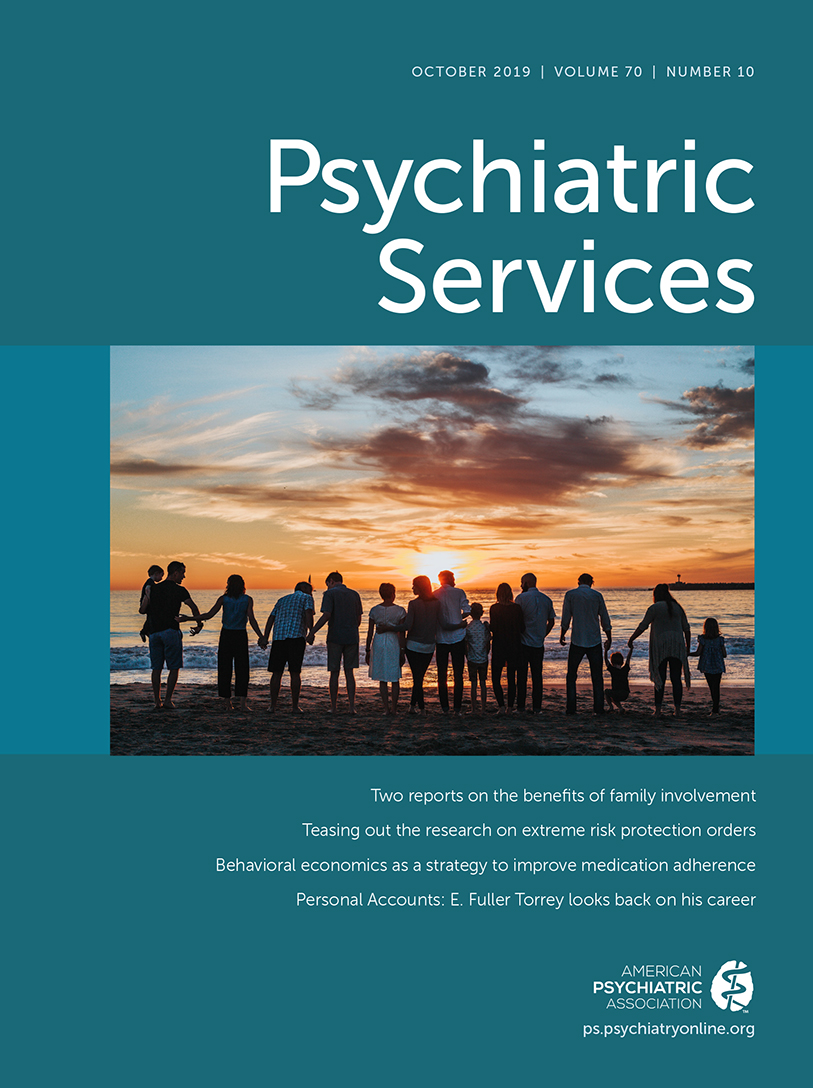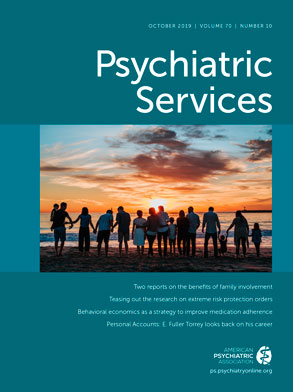Family members play an important role in the lives of people with mental illness and often seek information and support regarding available treatments, resources, and coping skills (
1). Services specifically for family members often use the peer-to-peer model to deliver psychoeducation and support to families of persons with mental illness. The National Alliance on Mental Illness (NAMI) offers the 12-session, in-person Family-to-Family Education Program (FTF). Previous research has documented the effectiveness of FTF for improving coping, empowerment, problem solving, experience of caregiving, and knowledge about mental illness (
2–
4). This study examines the efficacy of a modified FTF program titled NAMI Homefront, which is tailored for families of military service members or of veterans and is offered in person and online.
In the wake of increased military action following the terrorist attacks on September 11, 2001, the need for resources to help families of service members and of veterans has increased. In response, NAMI adapted the FTF program to create NAMI Homefront specifically for military and veteran families. This six-session program focuses on topics most relevant to military and veteran families, who often seek information specifically related to posttraumatic stress disorder (PTSD), anxiety, depression, and traumatic brain injury (
5). NAMI solely operates the Homefront program, but it often works with the U.S. Departments of Defense and Veterans Affairs for referrals, help promoting the classes, and classroom space.
Like FTF, NAMI Homefront is a highly structured, standardized curriculum, conducted by family members who have completed extensive training. In six 2.5-hour sessions, program participants receive information about mental illnesses, medication and other treatments, advocacy skills, and ways to develop emotional insight into their responses to mental illness. They also learn coping mechanisms including self-care, communication skills, problem-solving strategies, and crisis planning. To increase access to rural families, NAMI has adapted the program for online delivery (see online supplement to this article for course format descriptions).
A primary goal of NAMI Homefront is to fight stigma surrounding mental illness, which is especially prevalent in the military community (
6) and which often leaves family members feeling isolated and alone. The group atmosphere provides family members with a safe space to share their stories, exchange support and advice with peers, and better understand the shared experiences of military and veteran families. For some, the online option may offer a sense of anonymity and protection from stigma, allowing the program to reach active-duty military families while eliminating barriers presented by transportation, childcare, and caregiving for wounded veterans.
While the 12-session FTF program has established effectiveness, the impact of a six-session program for military and veteran families is unknown. This study aimed to determine whether family members or support persons who participate in the NAMI Homefront program experience benefits and whether the program benefits extend 3 months after program completion. A third exploratory aim was to determine whether the course format (in person versus online) moderated program effectiveness.
Methods
Participants were recruited from NAMI Homefront in-person and online classes being offered across the United States. In-person classes spanned 15 states (see the online supplement) in all U.S. regions. Program teachers were asked to inform program participants about the study and provide a copy of the study flyer to participants. Study participants enrolled from 22 in-person classes (N=63) and 12 online classes (N=56). (More detailed information about enrollment is in the online supplement.)
Inclusion criteria included being a family member or support person of a military service member or of a veteran with mental illness, speaking English, and being age 18 years or older. Participants provided verbal informed consent over the phone or online consent. Online questionnaires were administered at baseline, 6 weeks (postprogram), and 18 weeks (3-month follow-up) via the online survey platform Qualtrics. Interested individuals were encouraged to complete the consent and baseline questionnaire before or after the first class of the program. Participants could skip any questions on the surveys or indicate preference not to answer. Participants were given $20 to compensate for their time for each questionnaire completed. All study procedures were approved by the New York State Psychiatric Institute Institutional Review Board.
Questionnaires included validated instruments used in previous FTF studies (
2–
4). Demographic characteristics of participants and their service member or veteran family members were obtained at baseline, using the Family Experiences Interview Schedule (FEIS) (
7). Empowerment was assessed at all time points using the Family Empowerment Scale, which has three subscales: family, community, and service system empowerment (
8). We adapted a measure of knowledge from the FTF study and added four items related to military-specific content of the curriculum (
3). Family member subjective burden was evaluated with the FEIS worry and displeasure subscales (
7). Coping, specifically, emotional acceptance, was measured with the Brief COPE Inventory’s acceptance subscale (
9). We assessed family member psychological distress with the Brief Symptom Inventory (BSI-18) Global Severity Index, and subscales of anxiety, depression, and somatization (
10). The item “thoughts of ending your life” from the BSI-18 was removed from the questionnaire out of concern that the research team was not equipped to provide necessary support given that these surveys were distributed online and completed by individuals across the country. The scales that included this item were calculated using the formula for missing data described in the BSI-18 scoring and procedures manual. Family functioning was evaluated with the Family Assessment Device general functioning and problem-solving subscales (
11). Caregiving experience was measured with the Experience of Caregiving Inventory (ECI) overall positive scale, and subscales for positive personal experience and good aspects of relationship (
12). The surveys also provided information about class format, how many classes they had completed, and class location.
We applied descriptive statistics to characterize dependent measures at baseline, 6 weeks, and 18 weeks. We used chi squares and t tests to determine whether demographic and baseline outcome scores differed between participants who completed only a baseline assessment with those who completed one or more follow-up assessments. We conducted a mixed-effects model to examine change over time for each of the dependent measures. In an exploratory analysis, we examined the influence of class format (in person versus online) on outcomes by including a time × class format interaction term in models. We had 77% power to detect a medium (d=0.5) difference between the groups, prior to attrition. Analyses were conducted by using IBM SPSS Statistics version 25. To the extent we had overlapping measures, we compared the baseline characteristics of individuals participating in NAMI Homefront to those participating in the full 12-week FTF trial using t tests and chi-square statistics (see the
online supplement) (
2,
4).
Results
A total of 119 individuals (in person, N=63 [53%]; online, N=56 [47%]) enrolled in the study and completed a baseline questionnaire between March 2015 and October 2017. Of those, 105 (88%) completed a postprogram assessment (in person, N=53 [50%]; online, N=52 [50%]). A total of 99 participants (94% of those who completed a postprogram assessment, or 83% of those who completed a baseline assessment) completed the 3-month follow-up assessment. Of these participants, 48 (48%) were from in-person classes and 51 (52%) were from online classes. There were no significant differences between characteristics of participants who completed only a baseline assessment and those of participants who completed one or more follow-up assessments.
Table 1 shows demographic characteristics for the total sample and subgroups.
Homefront program outcomes over time are shown in
Table 2. All Family Empowerment Scale subscales, knowledge about mental illness, the COPE acceptance subscale, the BSI depression and anxiety subscales, Family Assessment Device subscales, and the ECI positive personal experience subscale showed statistically significant improvement between baseline and postprogram and between baseline and 3-month follow-up. The BSI Global Severity Index scale and FEIS displeasure subscale did not change from baseline to postprogram, but improvements were seen from baseline to 3-month follow-up. The BSI Somatization, FEIS worry, and ECI good aspect of relationship subscales did not change. Exploratory analyses revealed no differences between online and in-person formats. Therefore, in
Table 2 we report the more parsimonious model including only time.
Discussion and Conclusions
This study showed that the positive multidimensional effects of the 12-session FTF program observed in previous studies (
2–
4) were replicated in this study of the abbreviated NAMI Homefront program for military and veteran families. Although the absence of a control group precludes drawing conclusions about causation, NAMI Homefront was associated with statistically significant improvements in empowerment, coping, psychological distress, family functioning, experience of caregiving, and knowledge about mental illness, consistent with previous FTF studies. NAMI Homefront was also associated with improvements in depression and general family functioning (
2). It is interesting that the NAMI Homefront group did not improve on worry and positive aspects of caregiving, dimensions that were rated as more problematic among participants in the 12-week FTF trial but not among participants in this sample (
2,
4).
The finding that a six-session class produced results consistent with the 12-session format is notable. While the abbreviated format was effective for military and veteran families, we cannot assume it would be similarly effective for individuals who participate in the 12-session FTF program. In this study, participants were primarily spouses, and the most commonly reported diagnosis of their ill family member was PTSD. In contrast, our previous FTF study included primarily parents whose family members were most commonly reported to have bipolar disorder or schizophrenia; no FTF participants reported that a family member had PTSD (
13). The groups also differed in race, gender, and some key baseline characteristics—with the Homefront group experiencing not only more distress, less acceptance, and more problems with family functioning, but also more empowerment and less worry than the FTF participants. The preponderance of spouses participating in NAMI Homefront underscores the need to develop a greater understanding of the experiences and needs of these partners and the extent to which they are “caregiving” or coping with other stresses in the relationship (
14).
Another need of military and veteran families was an online course option to reach families in rural areas and allow families some anonymity if they have concerns about stigma in the military community. This study had an equal distribution of participants from in-person and online classes and found that outcomes were the same regardless of delivery. Online psychoeducation and support interventions for families of people with mental illness are understudied. The few published studies have focused on feasibility, usability, and acceptability of such online interventions (
15). Given that our study was not powered to detect small differences between formats, a larger study is needed to provide more definitive results. Furthermore, the lack of difference between groups could reflect that people chose the format most optimal for them.
Study limitations include the lack of control group and knowledge about individuals who took the class but did not participate in the study. It is possible that research participants were more likely to respond to NAMI Homefront than general program participants. Nevertheless, this study provides initial data that a six-session peer-taught family education program delivered in person or online is associated with a range of benefits for family members and support persons of service members or of veterans.

